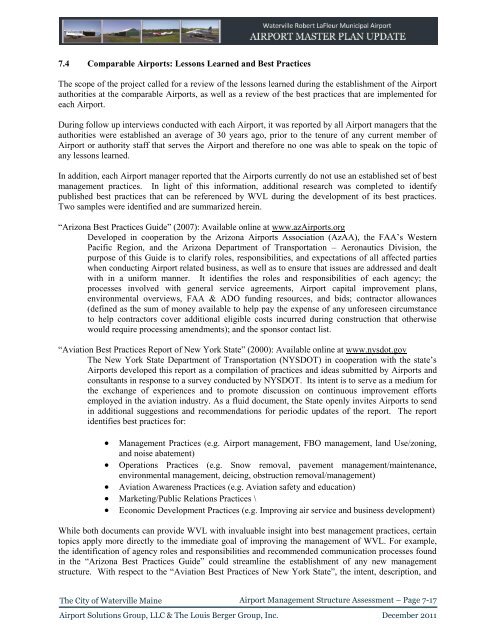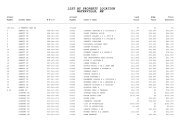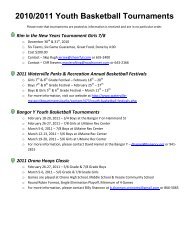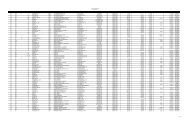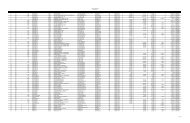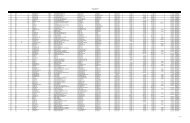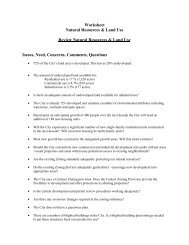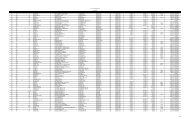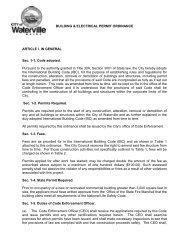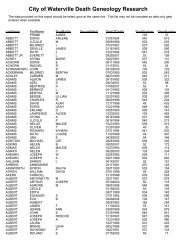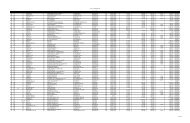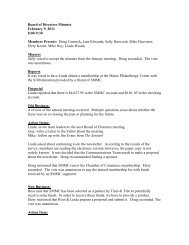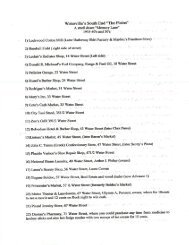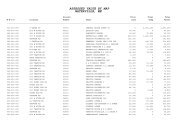Airport Master Plan 2012 - City of Waterville
Airport Master Plan 2012 - City of Waterville
Airport Master Plan 2012 - City of Waterville
Create successful ePaper yourself
Turn your PDF publications into a flip-book with our unique Google optimized e-Paper software.
7.4 Comparable <strong>Airport</strong>s: Lessons Learned and Best Practices<br />
The scope <strong>of</strong> the project called for a review <strong>of</strong> the lessons learned during the establishment <strong>of</strong> the <strong>Airport</strong><br />
authorities at the comparable <strong>Airport</strong>s, as well as a review <strong>of</strong> the best practices that are implemented for<br />
each <strong>Airport</strong>.<br />
During follow up interviews conducted with each <strong>Airport</strong>, it was reported by all <strong>Airport</strong> managers that the<br />
authorities were established an average <strong>of</strong> 30 years ago, prior to the tenure <strong>of</strong> any current member <strong>of</strong><br />
<strong>Airport</strong> or authority staff that serves the <strong>Airport</strong> and therefore no one was able to speak on the topic <strong>of</strong><br />
any lessons learned.<br />
In addition, each <strong>Airport</strong> manager reported that the <strong>Airport</strong>s currently do not use an established set <strong>of</strong> best<br />
management practices. In light <strong>of</strong> this information, additional research was completed to identify<br />
published best practices that can be referenced by WVL during the development <strong>of</strong> its best practices.<br />
Two samples were identified and are summarized herein.<br />
“Arizona Best Practices Guide” (2007): Available online at www.az<strong>Airport</strong>s.org<br />
Developed in cooperation by the Arizona <strong>Airport</strong>s Association (AzAA), the FAA’s Western<br />
Pacific Region, and the Arizona Department <strong>of</strong> Transportation – Aeronautics Division, the<br />
purpose <strong>of</strong> this Guide is to clarify roles, responsibilities, and expectations <strong>of</strong> all affected parties<br />
when conducting <strong>Airport</strong> related business, as well as to ensure that issues are addressed and dealt<br />
with in a uniform manner. It identifies the roles and responsibilities <strong>of</strong> each agency; the<br />
processes involved with general service agreements, <strong>Airport</strong> capital improvement plans,<br />
environmental overviews, FAA & ADO funding resources, and bids; contractor allowances<br />
(defined as the sum <strong>of</strong> money available to help pay the expense <strong>of</strong> any unforeseen circumstance<br />
to help contractors cover additional eligible costs incurred during construction that otherwise<br />
would require processing amendments); and the sponsor contact list.<br />
“Aviation Best Practices Report <strong>of</strong> New York State” (2000): Available online at www.nysdot.gov<br />
The New York State Department <strong>of</strong> Transportation (NYSDOT) in cooperation with the state’s<br />
<strong>Airport</strong>s developed this report as a compilation <strong>of</strong> practices and ideas submitted by <strong>Airport</strong>s and<br />
consultants in response to a survey conducted by NYSDOT. Its intent is to serve as a medium for<br />
the exchange <strong>of</strong> experiences and to promote discussion on continuous improvement efforts<br />
employed in the aviation industry. As a fluid document, the State openly invites <strong>Airport</strong>s to send<br />
in additional suggestions and recommendations for periodic updates <strong>of</strong> the report. The report<br />
identifies best practices for:<br />
Management Practices (e.g. <strong>Airport</strong> management, FBO management, land Use/zoning,<br />
and noise abatement)<br />
Operations Practices (e.g. Snow removal, pavement management/maintenance,<br />
environmental management, deicing, obstruction removal/management)<br />
Aviation Awareness Practices (e.g. Aviation safety and education)<br />
Marketing/Public Relations Practices \<br />
Economic Development Practices (e.g. Improving air service and business development)<br />
While both documents can provide WVL with invaluable insight into best management practices, certain<br />
topics apply more directly to the immediate goal <strong>of</strong> improving the management <strong>of</strong> WVL. For example,<br />
the identification <strong>of</strong> agency roles and responsibilities and recommended communication processes found<br />
in the “Arizona Best Practices Guide” could streamline the establishment <strong>of</strong> any new management<br />
structure. With respect to the “Aviation Best Practices <strong>of</strong> New York State”, the intent, description, and<br />
The <strong>City</strong> <strong>of</strong> <strong>Waterville</strong> Maine<br />
<strong>Airport</strong> Management Structure Assessment – Page 7-17<br />
<strong>Airport</strong> Solutions Group, LLC & The Louis Berger Group, Inc. December 2011


